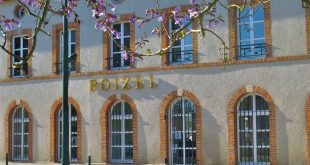

In 1976 the Codorniu cellar was accorded the status of an “Artistic Historical Monument”. Each year, around 120,000 people visit.
It is wonderfully reassuring that the oldest family business in Spain is dedicated to producing bubbles. Stream after endless stream of gravity-defying, upwardly mobile circles of wine. Each and every bubble infused with carbon dioxide that when it bursts, becomes a sparkle.
The Codornui story is that of winegrowers that hark back to the 16th Century. Their mission and motivations are today perpetuated by the 18th generation, making it Spain’s oldest family business, and the 17th most ancient in the world. It could even be older than that as the earliest documentary record only goes back to 1551, of Jaume Codorniu owning vineyards and wine presses. An equally momentous event took place 108 years after that.

Going back to 1551, Codornui is Spain’s oldest family business and the 17th most ancient in the world.

Bruno Colomer has been Chief Winemaker of Spain’s most renowned sparkling wine since 2008.
You may also want to read … Anna De Codorniu Blanc De Blancs Brut Reserva
In 1659 – heiress to the family business – Anna Codorniu married Miquel Raventos. As a result of that union, two wine dynasties became one. So was born Raventos Codorniu, perhaps Spain’s most famous winery.
The fabled story becomes sparkling in 1872.
In that year, Josep Raventos engineered the company to produce the first bottle of sparkling wine in Spain. No compromise was made because the farsighted Spaniard employed the traditional method of igniting the secondary fermentation inside the bottle. The very same formula the French use in Champagne. Only the varieties were different. The traditional Penedes grapes – xarel-lo, macabeo, and parellada – were called into service. So began the saga of Spanish Cava.
We often think – erroneously – that a company steeped in family tradition only look to the past. Far from it, because traditions begin their lives as innovation. In the case of the Raventos Codorniu company and family, an innovative flair has always been a part of their DNA. So it was that in 1984, they were the first to introduce chardonnay to Spanish Cava. Then, in 2002, pinot noir followed. Raventos Codorniu were also pioneers in using new, gentler pressing methods to get the most pristine juice from the grapes.
In order to produce good, great, wine you need outstanding fruit. Codorniu Cava is born in their family-owned sustainably farmed vineyards. What’s more. Codorniu is the only cava producer that uses fruit from three distinctive climate zones within D.O. Cava. These are:
- Penedes, where the rich clay/chalk soil and Mediterranean climate are what macabeo, xarel-lo and parellada thrive on
- Conca de Barbera, a more moderate continental climate with slate soils that are ideal for pinot noir
- Costers del Segre, also continental in climate and inland Catalonia, where the wide range between day- and night-time temperatures yield grapes with a high concentration of aromas, flavours and freshness that is ideal for chardonnay and pinot noir
Cava production is situated mainly in the wine-producing area of Penedes in Catalonia. The Codorniu cellars are in Sant Sadurni d’Anoia, the “Capital of Cava”.
In 1895 Manuel Raventos, son of Josep Raventos, commissioned Josep Puigi Cadafalch – a contemporary of Gaudi – to build a new wine cellar. The brief to the modernist architect was to capture the spirit of Codorniu. The buildings symbolise the fruitful alliance between nature and human endeavour. There is a labyrinth of underground cellars made of bricks spread over five levels where, for more than a century, every Codorniu Cava has had the secondary fermentation take place in the bottle. At the same time, the wines age under a constant temperature.

In 1895 Manuel Raventos commissioned modernist architect Josep Puig I Cadafalch – a contemporary of Gaudi – to build a new wine cellar.

There is a labyrinth of underground cellars spread over five levels where every Codorniu Cava undergoes the secondary fermentation.
In 1976 the Codorniu cellar was accorded the status of an “Artistic Historical Monument”. It remains the most impressive example of modern architecture dedicated to producting and ageing cava. Little wonder than that the cellar and buildings are visited by around 120,000 people each year. At the end of the visits, Spain’s most celebrated sparkling wine is served.
After the harvest, the grapes are gently pressed in order to extract only the finest juice. The different varieties and different plots are fermented separately in order to capture their different personality. Blending takes place later. Brut Nature, Brut and Semi-Seco are produced, the equivalent to Champagne’s Brut Zero, Brut and Demi-Sec.
At Codorniu, the bottles spend a minimum 9 to 12 months in the cellar. These wines have an unmistakeable fresh, fruity appeal. The next step up – Reserva – is aged a minimum 15 months, piling on more layers and nuances with the extended time. As for Gran Reserva, it takes on a totally different dimension as the wine becomes more evolved and complex for the longer “prison sentences” being locked up in the bottle …more than 30 months, often longer.
All great sparkling wine is time in a bottle.

Jaume Codorniu Gran Reserva – a serious, complex wine – is aged more than 30 months on lees.
You may also want to read … Jaume Codorniu Gran Reserva 2013 & Jaume Codorniu Gran Reserva 2008


